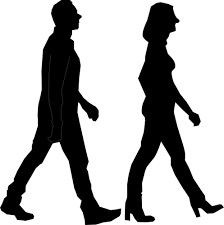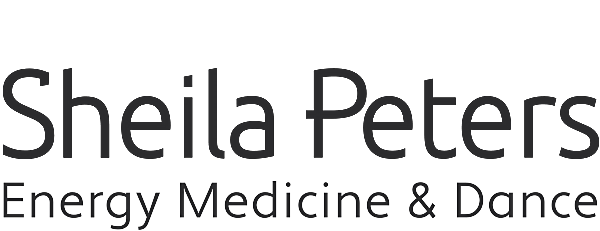
The other day in my Stretch/Body Awareness class, we did a very interesting exercise. I had my students follow each other around while walking in pairs with one person behind the other. As the followers observed from behind, I asked them to look at the posture and alignment of the person in front of them. I mentioned the strike of the foot – whether the heel touched down first or the ball of the foot; whether there was more weight on the outside or inside of the foot; did the feet wing out, move forward, or wing in; did one foot swing differently than the other? We moved up the body observing how much the knees bent, the hips and shoulders moved, how deep the breath was, how the arms swung, and the angle of the head.
As the follower noticed how the person in front moved, I asked the them to imitate the postural habits that were being observed. As they became more adept at walking like their partner, I then asked them to attempt to experience what it felt like to walk that way. What kind of emotions came up? How might this posture translate into how they felt about themselves and what it felt like interacting with the world this way? How much energy did they feel? As I mentioned in a previous blog from 2010, habitual posture translates into our attitude about life. I called that blog Posture as Philosophy.
When I wrote the previous blog, I was noticing the physical, emotional, and mental patterns that developed according to the habitual alignment that individuals maintained. Since then I have refined some of my observations about a person’s posture and what it indicates about their outlook on life.
For example, if a person regularly holds their weight primarily on their heels, it could indicate that they are reluctant to move forward. We can think of our legs and feet as a metaphor for moving forward emotionally and mentally, as they certainly are in a physical sense. If so, by maintaining a backward physical balance point perhaps we are indicating that we are not ready or maybe afraid to move forward emotionally or mentally when presented with a new opportunity. If this becomes our habitual stance might this mean we are constantly unsure about the future? Afraid to try new things? Have a mistrust about whatever might come our way? We may be in a real sense dragging our heels!
Conversely if we stand with our weight balanced on both the balls and heels of our feet, we may find that we can move forward more easily. In fact, it is easier to move in any direction when we are coming from a point of balance, so there is a greater sense of flexibility. Physically flexibility parallels emotional and mental flexibility.

Furthermore, when we stand by supporting ourselves on our heels we can quickly be overpowered by a good shove from any direction. However, like a tree whose roots are spread out all around the trunk, when our weight is evenly distributed on our feet, we can withstand a sharp push from any direction much more easily. We are already unbalanced when we rest on our heels so any small blow can topple us over.
All of these observations helped me to assist clients and students in changing their postural alignment. They immediately grasped the significance of what their posture was saying about their attitude about their lives. Many worked to change any imbalances and found that as their physical posture changed, their attitudes changed as well.
What I hadn’t understood at that point was that posture also creates energetic patterns.

A couple of years ago, in my energy medicine practice, I had the urge to check how energy was moving through a client’s body as she stood in her usual hyperextended knee stance. When the knees are locked back then the rest of the body will counteract the imbalance in alignment that is created, usually by tilting the pelvis, making the lower back arch, the stomach pooch out, the shoulders to push back, and the head to move forward. For every zig in body alignment there will always be counteracting zags.
While my client was in this zig-zag alignment, she tested weak for connecting up with yin energies. This meant she was not receiving about 50% of her available resources of energy. Just by standing in a misaligned physical posture! As soon as I asked her to bend her knees softly and bring her weight more over the balls of her feet, her pelvis came back into line, her lower back lengthened out, her stomach stopped pooching out and her shoulders and head came to rest in more anatomically correct positions. I retested her connection to yin energies and she suddenly tested strong, indicating that she now had use of all of the resources of energy available to her.
This was, for me, a striking insight! Although, as a former dancer, I had certainly understood the need for correct postural alignment in order to execute dance movements, I hadn’t fully understood that misaligned joints would affect how energetic forces (yin and yang) could be absorbed and utilized. Now it became even more apparent to me how important correct posture was for everyone, even beyond the more obvious physical, emotional, and mental benefits.
I began to check this out with my other clients and found that across the board how a person was routinely standing had a huge effect on how they were able to absorb and utilize yin and yang energies. Nowadays, I am always alert to how a new client stands and holds their body and am quick to demonstrate that posture is one sure way that they can very effectively begin to have more vitality on a physical level which translates into more vitality on an emotional, mental, and energetic level.
What does your current posture say about how you feel, think, and move forward, not only on a physical, emotional, and mental plane, but also on an energetic level?


